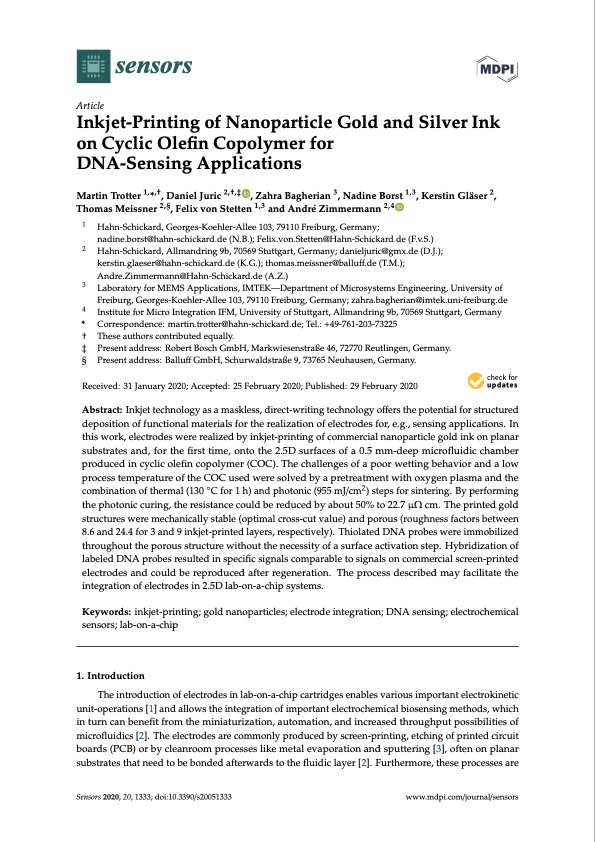
PDF Publication Title:
Text from PDF Page: 001
sensors Article Inkjet-Printing of Nanoparticle Gold and Silver Ink on Cyclic Olefin Copolymer for DNA-Sensing Applications Martin Trotter 1,*,†, Daniel Juric 2,†,‡ , Zahra Bagherian 3, Nadine Borst 1,3, Kerstin Gläser 2, Thomas Meissner 2,§, Felix von Stetten 1,3 and André Zimmermann 2,4 1 2 3 4 * Correspondence: martin.trotter@hahn-schickard.de; Tel.: +49-761-203-73225 † These authors contributed equally. ‡ Present address: Robert Bosch GmbH, Markwiesenstraße 46, 72770 Reutlingen, Germany. § Present address: Balluff GmbH, Schurwaldstraße 9, 73765 Neuhausen, Germany. Received: 31 January 2020; Accepted: 25 February 2020; Published: 29 February 2020 Hahn-Schickard, Georges-Koehler-Allee 103, 79110 Freiburg, Germany; nadine.borst@hahn-schickard.de (N.B.); Felix.von.Stetten@Hahn-Schickard.de (F.v.S.) Hahn-Schickard, Allmandring 9b, 70569 Stuttgart, Germany; danieljuric@gmx.de (D.J.); kerstin.glaeser@hahn-schickard.de (K.G.); thomas.meissner@balluff.de (T.M.); Andre.Zimmermann@Hahn-Schickard.de (A.Z.) Laboratory for MEMS Applications, IMTEK—Department of Microsystems Engineering, University of Freiburg, Georges-Koehler-Allee 103, 79110 Freiburg, Germany; zahra.bagherian@imtek.uni-freiburg.de Institute for Micro Integration IFM, University of Stuttgart, Allmandring 9b, 70569 Stuttgart, Germany Abstract: Inkjet technology as a maskless, direct-writing technology offers the potential for structured deposition of functional materials for the realization of electrodes for, e.g., sensing applications. In this work, electrodes were realized by inkjet-printing of commercial nanoparticle gold ink on planar substrates and, for the first time, onto the 2.5D surfaces of a 0.5 mm-deep microfluidic chamber produced in cyclic olefin copolymer (COC). The challenges of a poor wetting behavior and a low process temperature of the COC used were solved by a pretreatment with oxygen plasma and the combination of thermal (130 ◦C for 1 h) and photonic (955 mJ/cm2) steps for sintering. By performing the photonic curing, the resistance could be reduced by about 50% to 22.7 μΩ cm. The printed gold structures were mechanically stable (optimal cross-cut value) and porous (roughness factors between 8.6 and 24.4 for 3 and 9 inkjet-printed layers, respectively). Thiolated DNA probes were immobilized throughout the porous structure without the necessity of a surface activation step. Hybridization of labeled DNA probes resulted in specific signals comparable to signals on commercial screen-printed electrodes and could be reproduced after regeneration. The process described may facilitate the integration of electrodes in 2.5D lab-on-a-chip systems. Keywords: inkjet-printing; gold nanoparticles; electrode integration; DNA sensing; electrochemical sensors; lab-on-a-chip 1. Introduction The introduction of electrodes in lab-on-a-chip cartridges enables various important electrokinetic unit-operations [1] and allows the integration of important electrochemical biosensing methods, which in turn can benefit from the miniaturization, automation, and increased throughput possibilities of microfluidics [2]. The electrodes are commonly produced by screen-printing, etching of printed circuit boards (PCB) or by cleanroom processes like metal evaporation and sputtering [3], often on planar substrates that need to be bonded afterwards to the fluidic layer [2]. Furthermore, these processes are Sensors 2020, 20, 1333; doi:10.3390/s20051333 www.mdpi.com/journal/sensorsPDF Image | Inkjet-Printing Nanoparticle Gold Silver Ink Cyclic Olefin

PDF Search Title:
Inkjet-Printing Nanoparticle Gold Silver Ink Cyclic OlefinOriginal File Name Searched:
sensors-20-01333-v2.pdfDIY PDF Search: Google It | Yahoo | Bing
Turbine and System Plans CAD CAM: Special for this month, any plans are $10,000 for complete Cad/Cam blueprints. License is for one build. Try before you buy a production license. More Info
Waste Heat Power Technology: Organic Rankine Cycle uses waste heat to make electricity, shaft horsepower and cooling. More Info
All Turbine and System Products: Infinity Turbine ORD systems, turbine generator sets, build plans and more to use your waste heat from 30C to 100C. More Info
CO2 Phase Change Demonstrator: CO2 goes supercritical at 30 C. This is a experimental platform which you can use to demonstrate phase change with low heat. Includes integration area for small CO2 turbine, static generator, and more. This can also be used for a GTL Gas to Liquids experimental platform. More Info
Introducing the Infinity Turbine Products Infinity Turbine develops and builds systems for making power from waste heat. It also is working on innovative strategies for storing, making, and deploying energy. More Info
Need Strategy? Use our Consulting and analyst services Infinity Turbine LLC is pleased to announce its consulting and analyst services. We have worked in the renewable energy industry as a researcher, developing sales and markets, along with may inventions and innovations. More Info
Made in USA with Global Energy Millennial Web Engine These pages were made with the Global Energy Web PDF Engine using Filemaker (Claris) software.
Infinity Turbine Developing Spinning Disc Reactor SDR or Spinning Disc Reactors reduce processing time for liquid production of Silver Nanoparticles.
| CONTACT TEL: 608-238-6001 Email: greg@infinityturbine.com | RSS | AMP |